…Ťľ∆§ňīū§®§Ō§ §§§ę§ťŐŧ∑§∆§Ŗ§Ť§¶
1 like1,271 views
2017/07/01§ňť_īŖ§Ķ§ž§Ņ Developers.IO 2017 §őįkĪŪŔYŃŌ§«§Ļ°£ http://dev.classmethod.jp/news/developers-io-2017/
1 of 52
Download to read offline









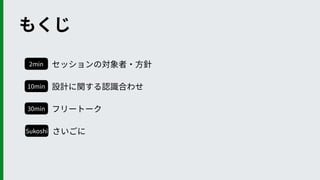
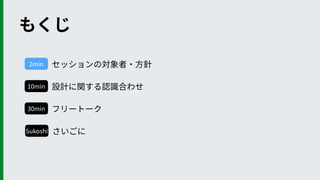

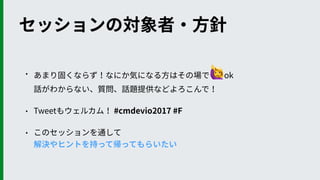
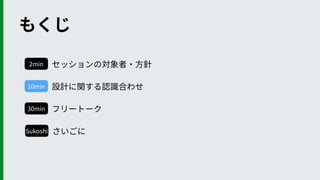


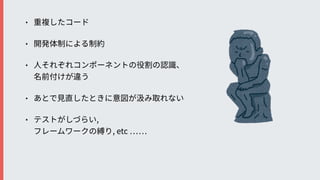























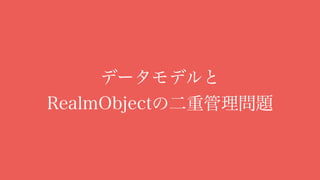











Ad
Recommended
§≥§ů§ Ľ≠√ś“ż§≠∂…§∑§Ō§§§š§ņ£°
§≥§ů§ Ľ≠√ś“ż§≠∂…§∑§Ō§§§š§ņ£°ÜôŐ≠ņ… ĆýīŚ
?
į≥§ő‘í§Ú¬Ą§Ī£°£°LTīůĽŠ #8§őŔYŃŌ§«§Ļ°£
https://cdg.connpass.com/event/81429/§»§ň§ę§ĮėS§∑§∆≥’≥‹Īū.¬Š≤ű§«į’≤‚ĪŤĪū≥ß≥¶įýĺĪĪŤ≥Ŕ§Ú Ļ§§§Ņ§§
§»§ň§ę§ĮėS§∑§∆≥’≥‹Īū.¬Š≤ű§«į’≤‚ĪŤĪū≥ß≥¶įýĺĪĪŤ≥Ŕ§Ú Ļ§§§Ņ§§§Ķ§Į§ť•§•ů•Ņ©`•Õ•√•»÷Í ĹĽŠ…Á
?
2017/10/25(ňģ)
§Ķ§Į§ť§őŌ¶§Ŕ °ł§Ķ§Į§ť•§•ů•Ņ©`•Õ•√•»§ő•®•ů•ł•ň•Ę§Ō Vue.js §Ú§≥§ů§ ÔL§ň§ń§ę§√§∆§ř§Ļ°Ļ
įkĪŪ’Ŗ: §Ķ§Į§ť•§•ů•Ņ©`•Õ•√•»°°ļSŐÔ ’ś“Ľ–¬“é•’?•Ū•∑?•ß•Į•»§ō§ő Vue.js x SPA x SSR §őĆß»Ž
–¬“é•’?•Ū•∑?•ß•Į•»§ō§ő Vue.js x SPA x SSR §őĆß»ŽKazuyoshi Tsuchiya
?
2017.08.28 •ŕ•—•‹•∆•√•Į•ę•ů•’•°•ž•ů•Ļ#9 °ę Vue.js ŐōľĮ °ę
https://pepabo.connpass.com/event/63559/FatViewController§Úį≤»ę§ňēݧ≠ďQ§®§Ž∑Ĺ∑®§¨“ä§ń§ę§ť§ §ę§√§Ņ§ő§«°Ę§…§¶§§§¶Õī§Ŗ§Ú‘S»›§Ļ§Ž§ęŅľ§®§Ņ #iosdcKenji Tanaka
?
Le document aborde des aspects techniques li®¶s ®§ la gestion des vues dans le d®¶veloppement iOS, en se concentrant sur des ®¶l®¶ments comme 'viewcontroller' et 'uiwindow'. Il mentionne des ressources et des exemples associ®¶s, notamment des liens vers Qiita. Ce contenu semble destin®¶ aux d®¶veloppeurs int®¶ress®¶s par les pratiques de programmation sur iOS.•Í•Í©`•Ļ«į§ő•Í•į•ž•√•∑•Á•ů•∆•Ļ•»§¨§Š§ů§…§§£°§ő§«Magic Pod§«UI•∆•Ļ•»§Ú‘á§∑§∆§Ŗ§Ž #pixiv_app_night
•Í•Í©`•Ļ«į§ő•Í•į•ž•√•∑•Á•ů•∆•Ļ•»§¨§Š§ů§…§§£°§ő§«Magic Pod§«UI•∆•Ļ•»§Ú‘á§∑§∆§Ŗ§Ž #pixiv_app_nightKenji Tanaka
?
The document discusses Magic Pod, a tool for testing iOS user interfaces. It mentions that Magic Pod can be used for testing iOS UI with XCUITest, developing AI and GUI interfaces, and using Appium. It also notes that Magic Pod has desktop functionality and can be integrated with CI/CD tools like Bitrise.•›•Ļ•»•‚©`•∆•ŗ§š§√§∆§Ŗ§Ņ #yjbonfireKenji Tanaka
?
Le document est un ®¶change sur Twitter concernant le d®¶veloppement iOS, notamment en lien avec des projets de recherche et d®¶veloppement utilisant Swift et TDD. Il fait ®¶galement mention de publications et ressources pertinentes sur pixiv et Amazon. Enfin, des informations sur des ®¶v®¶nements et des contributions sont partag®¶es dans la discussion.2§ń§őÕ¨∆ŕ 4§ń§ő◊īĎB #pixiv_ios_arch
2§ń§őÕ¨∆ŕ 4§ń§ő◊īĎB #pixiv_ios_archKenji Tanaka
?
This document discusses different architectures for structuring GUI and state management in iOS applications. It covers common patterns like MVC, MVP, MVVM as well as concepts like separation of presentation and domain layers. Specific topics covered include screen state, presentation state, session state, record state, observer synchronization, flow synchronization, and how these relate to architectural patterns like clean architecture. Overall the document provides an overview of options for structuring the different state aspects of iOS applications.2§ń§őÕ¨∆ŕ 4§ń§ő◊īĎB #app_mp
2§ń§őÕ¨∆ŕ 4§ń§ő◊īĎB #app_mpKenji Tanaka
?
This document discusses different architectures for structuring GUI and state management in mobile apps. It covers common patterns like MVC, MVP, MVVM and their use of screens, presentation, session and record states. It also discusses separating these states using clean architecture principles with layers for presentation, domain and data. Specific technologies and frameworks mentioned include Swift, TDD, NotificationCenter, Realm and various iOS GUI frameworks.2§ń§őÕ¨∆ŕ 4§ń§ő◊īĎB #roppongiswift
2§ń§őÕ¨∆ŕ 4§ń§ő◊īĎB #roppongiswiftKenji Tanaka
?
This document discusses GUI architectures and state management patterns for iOS apps. It describes common GUI architectures like MVC, MVP, MVVM as well as state management approaches like Flux and Redux. It also maps these patterns onto the domains of the clean architecture pattern. The document separates state into screen, presentation, session, and record states and provides examples of managing each state type.•»©`•Į•ů•Í•’•ž•√•∑•ŚĄIņŪ§Úļ¨§ŗAPIClient§ő•∆•Ļ•» #hakata_test_night
•»©`•Į•ů•Í•’•ž•√•∑•ŚĄIņŪ§Úļ¨§ŗAPIClient§ő•∆•Ļ•» #hakata_test_nightKenji Tanaka
?
The document discusses testing APIs and network requests using stubs and mocks. It provides examples of setting up stubs using OHHTTPStubs to mock API responses for different test cases. It also shows how to use XCTContext to run tests with expectations and wait for expectations to be fulfilled before cleaning up stubs. Key points covered include setting up stubs, activating and deactivating stubs, defining test responses, making requests and asserting on responses using expectations.§Ť§Į Ļ§¶•∆•Ļ•»•ō•Ž•—©`§őĹBĹť #ios_test_night
§Ť§Į Ļ§¶•∆•Ļ•»•ō•Ž•—©`§őĹBĹť #ios_test_nightKenji Tanaka
?
The document summarizes techniques for testing JSON parsing and HTTP requests in iOS. It shows how to load test JSON data from bundled files using a TestDataHelper class. It also demonstrates improving HTTP stubbing by creating an HTTPStub struct to activate and deactivate stub responses. The last part announces an upcoming iOS test night on December 14th at Pixiv Inc.…Ťľ∆ ĪŅ’§ő•Í•’•°•Į•Ņ•Í•ů•į
…Ťľ∆ ĪŅ’§ő•Í•’•°•Į•Ņ•Í•ů•įKenji Tanaka
?
The document discusses a presentation given by Danbo-Tanaka at iOSDC Japan 2018 on August 31st in Track A at 8:20 PM about testing iOS applications. It mentions using test-driven development (TDD) techniques as recommended by Martin Fowler. It also references a iOS Test Night event and a WACATE group. The presentation covers topics like static analysis, resolving issues, architectural patterns, clean system design, and continuous integration/delivery using Bitrise.WACATE 2018 Summer
WACATE 2018 SummerKenji Tanaka
?
iOS Test Night #8§őŔYŃŌ§«§Ļ°£
https://testnight.connpass.com/event/90959/An iOS Engineer challenges Web.
An iOS Engineer challenges Web.Kenji Tanaka
?
SWWDC(Ō…Ő®iOSť_įk’Ŗ•≥•Ŗ•Ś•ň•∆•£)-34 ∑ī °§∑§Ņ§Í’٧Í∑Ķ§√§Ņ§Í§Ļ§Ž•◊•ž•ľ•ůĽŠ ľś ÕŁńÍĽŠ2017
https://atnd.org/events/93483
§őĶ«ČĮŔYŃŌ°£2017ńͧڒ٧Í∑Ķ§Ž•®•ů•∑?•ň•Ę§ő§Ņ§Š§ő•’?•Ū•Į?Ĺ≤◊ý≥’Īūįý4
•®•ů•∑?•ň•Ę§ő§Ņ§Š§ő•’?•Ū•Į?Ĺ≤◊ý≥’Īūįý4Kenji Tanaka
?
2017/11/22§ňŅ™īŖ§Ķ§ž§Ņ°ł•®•ů•ł•ň•Ę§ő§Ņ§Š§ő•÷•Ū•įĹ≤◊ý°Ļ§ő◊ ŃŌ§«§Ļ°£•Ļ•»•ž•Ļ…ÁĽŠ§ň…ķ§≠§Ž°ĘĺĪįŅ≥ß•®•ů•∑?•ň•Ę§ň•™•Ļ•Ļ•Š§Ļ§ŽįŔļŌ§ő ņĹÁ§»◊ų∆∑
•Ļ•»•ž•Ļ…ÁĽŠ§ň…ķ§≠§Ž°ĘĺĪįŅ≥ß•®•ů•∑?•ň•Ę§ň•™•Ļ•Ļ•Š§Ļ§ŽįŔļŌ§ő ņĹÁ§»◊ų∆∑Kenji Tanaka
?
2017/10/03 į≥•≥•ů LTŔYŃŌ
https://orecon.connpass.com/event/64285/Ĺŕ◊”°Ę§Ĺ§ž≥’ĺĪĪū∑…įšī«≤‘≥Ŕįýī«ĪŰĪŰĪūįý§š§ §§...°ĘĻů≤Ļ≥Ŕ≥’ĺĪĪū∑…įšī«≤‘≥Ŕįýī«ĪŰĪŰĪūįý§š...°£
Ĺŕ◊”°Ę§Ĺ§ž≥’ĺĪĪū∑…įšī«≤‘≥Ŕįýī«ĪŰĪŰĪūįý§š§ §§...°ĘĻů≤Ļ≥Ŕ≥’ĺĪĪū∑…įšī«≤‘≥Ŕįýī«ĪŰĪŰĪūįý§š...°£Kenji Tanaka
?
The document describes code for displaying player stats from a pubg tracking service. It includes a StatsPresenter class that fetches stats from a data store based on a player's nickname. The presenter updates the stats on a StatsViewController by calling methods to reload the table view and display the player's profile.iOS 11§ę§ť§őDeviceCheck #§»§Ō
iOS 11§ę§ť§őDeviceCheck #§»§ŌKenji Tanaka
?
This document discusses Chris Lattner, the creator of the Swift programming language. It contains his picture from a WWDC Swift panel and mentions Swift version 7. The end contains emojis pondering and thinking about Swift.iOS 11§ę§ť§ő•Ę•’?•Íťg•’•°•§•ŽĻ≤”–
iOS 11§ę§ť§ő•Ę•’?•Íťg•’•°•§•ŽĻ≤”–Kenji Tanaka
?
This document summarizes features for building document-based apps in iOS 11, including UIDocumentBrowserViewController, FileProvider, and settings in the app's Info.plist. It provides an overview of how to set up document support and export/import uniform type identifiers to share documents between apps and extensions. Code samples and demo apps are shown for browsing and opening documents from other apps and cloud services using the new iOS 11 APIs.iOS 11§ę§ť§ő•Ę•’?•Íťg•’•°•§•ŽĻ≤”–_Ļęť_”√
iOS 11§ę§ť§ő•Ę•’?•Íťg•’•°•§•ŽĻ≤”–_Ļęť_”√Kenji Tanaka
?
This document summarizes key points about building document-based apps in iOS 11. It discusses new features like FileProvider, FileProviderUI and UIDocumentBrowserViewController that allow apps to integrate with the Files app and share documents between apps. It also provides information on configuring app targets and entitlements to support these features, including setting document types and roles in the app's Info.plist file. Code samples and demos were shown on building a basic document-based app that supports opening files from other apps and services using the new iOS 11 APIs.≤őľ”’Ŗ§»’٧Í∑Ķ§ŽWWDC17 Ļęť_”√
≤őľ”’Ŗ§»’٧Í∑Ķ§ŽWWDC17 Ļęť_”√Kenji Tanaka
?
The document discusses a Twitter thread from @ktanaka117 about their experience at WWDC 2017 in San Jose. It includes many tweets expressing excitement about attending sessions, labs, the keynote, and other events at the conference, as well as photos and check-ins from San Jose.į¬į¬į¬∂Ŕįš§ő’٧Í∑Ķ§Í§Ú ľ§Š§Ž§Ņ§Š§ň
į¬į¬į¬∂Ŕįš§ő’٧Í∑Ķ§Í§Ú ľ§Š§Ž§Ņ§Š§ňKenji Tanaka
?
The document announces that WWDC will take place on June 13th in Akiba and that Swift developers are needed. It expresses excitement for WWDC and thanks people for listening.Stub§Ž - Mockingjay§Ú Ļ§√§ŅHTTP•Į•ť•§•Ę•ů•»§ő•∆•Ļ•» -
Stub§Ž - Mockingjay§Ú Ļ§√§ŅHTTP•Į•ť•§•Ę•ů•»§ő•∆•Ļ•» -Kenji Tanaka
?
This document contains Swift code for testing a HTTP request to an API using the Alamofire and Mockingjay libraries. It defines a test spec class with a describe block for "hoge" and a context block for "fuga". Within the "fuga" context, a beforeEach stub is set up to mock API responses from the "hogefugapiyo.com" domain. The single "piyo" test makes a request, asserts the response is not nil, and prints the results.√ŤĽ≠§»•“?•∑?•Õ•Ļ§Ú•Į•Í©`•ů§ň∑÷§Ī§Ž Osaka Ļęť_”√
√ŤĽ≠§»•“?•∑?•Õ•Ļ§Ú•Į•Í©`•ů§ň∑÷§Ī§Ž Osaka Ļęť_”√Kenji Tanaka
?
The document describes refactoring code to follow the Model-View-Presenter (MVP) pattern. It starts with a ViewController that directly calls a TwitterManager to get tweets. It is refactored to introduce a Presenter that handles getting the tweets and notifying the ViewController to reload its table view. The Presenter retrieves tweets from the TwitterManager and calls a method on the ViewController, which conforms to a ViewControllerOutput protocol, to reload the table view.ĺĪįŅ≥ß•Į•Í©`•ů•Ę©`•≠•∆•Į•Ń•„§ő•∆?©`•ŅĎť¬‘ĻęŅ™”√
ĺĪįŅ≥ß•Į•Í©`•ů•Ę©`•≠•∆•Į•Ń•„§ő•∆?©`•ŅĎť¬‘ĻęŅ™”√Kenji Tanaka
?
The document describes a class called SomePresenter that contains a method called tappedButton. When tappedButton is called, it uses someModel to get a list and handles the response. If getting the list succeeds, it sets the list property to the returned RealmObject and reloads the table view. If getting the list fails, it handles the error.More Related Content
More from Kenji Tanaka (20)
2§ń§őÕ¨∆ŕ 4§ń§ő◊īĎB #roppongiswift
2§ń§őÕ¨∆ŕ 4§ń§ő◊īĎB #roppongiswiftKenji Tanaka
?
This document discusses GUI architectures and state management patterns for iOS apps. It describes common GUI architectures like MVC, MVP, MVVM as well as state management approaches like Flux and Redux. It also maps these patterns onto the domains of the clean architecture pattern. The document separates state into screen, presentation, session, and record states and provides examples of managing each state type.•»©`•Į•ů•Í•’•ž•√•∑•ŚĄIņŪ§Úļ¨§ŗAPIClient§ő•∆•Ļ•» #hakata_test_night
•»©`•Į•ů•Í•’•ž•√•∑•ŚĄIņŪ§Úļ¨§ŗAPIClient§ő•∆•Ļ•» #hakata_test_nightKenji Tanaka
?
The document discusses testing APIs and network requests using stubs and mocks. It provides examples of setting up stubs using OHHTTPStubs to mock API responses for different test cases. It also shows how to use XCTContext to run tests with expectations and wait for expectations to be fulfilled before cleaning up stubs. Key points covered include setting up stubs, activating and deactivating stubs, defining test responses, making requests and asserting on responses using expectations.§Ť§Į Ļ§¶•∆•Ļ•»•ō•Ž•—©`§őĹBĹť #ios_test_night
§Ť§Į Ļ§¶•∆•Ļ•»•ō•Ž•—©`§őĹBĹť #ios_test_nightKenji Tanaka
?
The document summarizes techniques for testing JSON parsing and HTTP requests in iOS. It shows how to load test JSON data from bundled files using a TestDataHelper class. It also demonstrates improving HTTP stubbing by creating an HTTPStub struct to activate and deactivate stub responses. The last part announces an upcoming iOS test night on December 14th at Pixiv Inc.…Ťľ∆ ĪŅ’§ő•Í•’•°•Į•Ņ•Í•ů•į
…Ťľ∆ ĪŅ’§ő•Í•’•°•Į•Ņ•Í•ů•įKenji Tanaka
?
The document discusses a presentation given by Danbo-Tanaka at iOSDC Japan 2018 on August 31st in Track A at 8:20 PM about testing iOS applications. It mentions using test-driven development (TDD) techniques as recommended by Martin Fowler. It also references a iOS Test Night event and a WACATE group. The presentation covers topics like static analysis, resolving issues, architectural patterns, clean system design, and continuous integration/delivery using Bitrise.WACATE 2018 Summer
WACATE 2018 SummerKenji Tanaka
?
iOS Test Night #8§őŔYŃŌ§«§Ļ°£
https://testnight.connpass.com/event/90959/An iOS Engineer challenges Web.
An iOS Engineer challenges Web.Kenji Tanaka
?
SWWDC(Ō…Ő®iOSť_įk’Ŗ•≥•Ŗ•Ś•ň•∆•£)-34 ∑ī °§∑§Ņ§Í’٧Í∑Ķ§√§Ņ§Í§Ļ§Ž•◊•ž•ľ•ůĽŠ ľś ÕŁńÍĽŠ2017
https://atnd.org/events/93483
§őĶ«ČĮŔYŃŌ°£2017ńͧڒ٧Í∑Ķ§Ž•®•ů•∑?•ň•Ę§ő§Ņ§Š§ő•’?•Ū•Į?Ĺ≤◊ý≥’Īūįý4
•®•ů•∑?•ň•Ę§ő§Ņ§Š§ő•’?•Ū•Į?Ĺ≤◊ý≥’Īūįý4Kenji Tanaka
?
2017/11/22§ňŅ™īŖ§Ķ§ž§Ņ°ł•®•ů•ł•ň•Ę§ő§Ņ§Š§ő•÷•Ū•įĹ≤◊ý°Ļ§ő◊ ŃŌ§«§Ļ°£•Ļ•»•ž•Ļ…ÁĽŠ§ň…ķ§≠§Ž°ĘĺĪįŅ≥ß•®•ů•∑?•ň•Ę§ň•™•Ļ•Ļ•Š§Ļ§ŽįŔļŌ§ő ņĹÁ§»◊ų∆∑
•Ļ•»•ž•Ļ…ÁĽŠ§ň…ķ§≠§Ž°ĘĺĪįŅ≥ß•®•ů•∑?•ň•Ę§ň•™•Ļ•Ļ•Š§Ļ§ŽįŔļŌ§ő ņĹÁ§»◊ų∆∑Kenji Tanaka
?
2017/10/03 į≥•≥•ů LTŔYŃŌ
https://orecon.connpass.com/event/64285/Ĺŕ◊”°Ę§Ĺ§ž≥’ĺĪĪū∑…įšī«≤‘≥Ŕįýī«ĪŰĪŰĪūįý§š§ §§...°ĘĻů≤Ļ≥Ŕ≥’ĺĪĪū∑…įšī«≤‘≥Ŕįýī«ĪŰĪŰĪūįý§š...°£
Ĺŕ◊”°Ę§Ĺ§ž≥’ĺĪĪū∑…įšī«≤‘≥Ŕįýī«ĪŰĪŰĪūįý§š§ §§...°ĘĻů≤Ļ≥Ŕ≥’ĺĪĪū∑…įšī«≤‘≥Ŕįýī«ĪŰĪŰĪūįý§š...°£Kenji Tanaka
?
The document describes code for displaying player stats from a pubg tracking service. It includes a StatsPresenter class that fetches stats from a data store based on a player's nickname. The presenter updates the stats on a StatsViewController by calling methods to reload the table view and display the player's profile.iOS 11§ę§ť§őDeviceCheck #§»§Ō
iOS 11§ę§ť§őDeviceCheck #§»§ŌKenji Tanaka
?
This document discusses Chris Lattner, the creator of the Swift programming language. It contains his picture from a WWDC Swift panel and mentions Swift version 7. The end contains emojis pondering and thinking about Swift.iOS 11§ę§ť§ő•Ę•’?•Íťg•’•°•§•ŽĻ≤”–
iOS 11§ę§ť§ő•Ę•’?•Íťg•’•°•§•ŽĻ≤”–Kenji Tanaka
?
This document summarizes features for building document-based apps in iOS 11, including UIDocumentBrowserViewController, FileProvider, and settings in the app's Info.plist. It provides an overview of how to set up document support and export/import uniform type identifiers to share documents between apps and extensions. Code samples and demo apps are shown for browsing and opening documents from other apps and cloud services using the new iOS 11 APIs.iOS 11§ę§ť§ő•Ę•’?•Íťg•’•°•§•ŽĻ≤”–_Ļęť_”√
iOS 11§ę§ť§ő•Ę•’?•Íťg•’•°•§•ŽĻ≤”–_Ļęť_”√Kenji Tanaka
?
This document summarizes key points about building document-based apps in iOS 11. It discusses new features like FileProvider, FileProviderUI and UIDocumentBrowserViewController that allow apps to integrate with the Files app and share documents between apps. It also provides information on configuring app targets and entitlements to support these features, including setting document types and roles in the app's Info.plist file. Code samples and demos were shown on building a basic document-based app that supports opening files from other apps and services using the new iOS 11 APIs.≤őľ”’Ŗ§»’٧Í∑Ķ§ŽWWDC17 Ļęť_”√
≤őľ”’Ŗ§»’٧Í∑Ķ§ŽWWDC17 Ļęť_”√Kenji Tanaka
?
The document discusses a Twitter thread from @ktanaka117 about their experience at WWDC 2017 in San Jose. It includes many tweets expressing excitement about attending sessions, labs, the keynote, and other events at the conference, as well as photos and check-ins from San Jose.į¬į¬į¬∂Ŕįš§ő’٧Í∑Ķ§Í§Ú ľ§Š§Ž§Ņ§Š§ň
į¬į¬į¬∂Ŕįš§ő’٧Í∑Ķ§Í§Ú ľ§Š§Ž§Ņ§Š§ňKenji Tanaka
?
The document announces that WWDC will take place on June 13th in Akiba and that Swift developers are needed. It expresses excitement for WWDC and thanks people for listening.Stub§Ž - Mockingjay§Ú Ļ§√§ŅHTTP•Į•ť•§•Ę•ů•»§ő•∆•Ļ•» -
Stub§Ž - Mockingjay§Ú Ļ§√§ŅHTTP•Į•ť•§•Ę•ů•»§ő•∆•Ļ•» -Kenji Tanaka
?
This document contains Swift code for testing a HTTP request to an API using the Alamofire and Mockingjay libraries. It defines a test spec class with a describe block for "hoge" and a context block for "fuga". Within the "fuga" context, a beforeEach stub is set up to mock API responses from the "hogefugapiyo.com" domain. The single "piyo" test makes a request, asserts the response is not nil, and prints the results.√ŤĽ≠§»•“?•∑?•Õ•Ļ§Ú•Į•Í©`•ů§ň∑÷§Ī§Ž Osaka Ļęť_”√
√ŤĽ≠§»•“?•∑?•Õ•Ļ§Ú•Į•Í©`•ů§ň∑÷§Ī§Ž Osaka Ļęť_”√Kenji Tanaka
?
The document describes refactoring code to follow the Model-View-Presenter (MVP) pattern. It starts with a ViewController that directly calls a TwitterManager to get tweets. It is refactored to introduce a Presenter that handles getting the tweets and notifying the ViewController to reload its table view. The Presenter retrieves tweets from the TwitterManager and calls a method on the ViewController, which conforms to a ViewControllerOutput protocol, to reload the table view.ĺĪįŅ≥ß•Į•Í©`•ů•Ę©`•≠•∆•Į•Ń•„§ő•∆?©`•ŅĎť¬‘ĻęŅ™”√
ĺĪįŅ≥ß•Į•Í©`•ů•Ę©`•≠•∆•Į•Ń•„§ő•∆?©`•ŅĎť¬‘ĻęŅ™”√Kenji Tanaka
?
The document describes a class called SomePresenter that contains a method called tappedButton. When tappedButton is called, it uses someModel to get a list and handles the response. If getting the list succeeds, it sets the list property to the returned RealmObject and reloads the table view. If getting the list fails, it handles the error.Ĺŕ◊”°Ę§Ĺ§ž≥’ĺĪĪū∑…įšī«≤‘≥Ŕįýī«ĪŰĪŰĪūįý§š§ §§...°ĘĻů≤Ļ≥Ŕ≥’ĺĪĪū∑…įšī«≤‘≥Ŕįýī«ĪŰĪŰĪūįý§š...°£
Ĺŕ◊”°Ę§Ĺ§ž≥’ĺĪĪū∑…įšī«≤‘≥Ŕįýī«ĪŰĪŰĪūįý§š§ §§...°ĘĻů≤Ļ≥Ŕ≥’ĺĪĪū∑…įšī«≤‘≥Ŕįýī«ĪŰĪŰĪūįý§š...°£Kenji Tanaka
?
